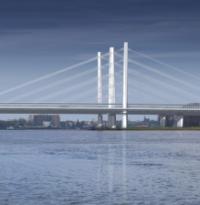Over the coming months another 14 sections measuring 60m wide by 12.5m long will be installed.
The installation cycle for each deck segment is divided into four main steps, which take place over the course of around three weeks.
First, the moveable lifting beams raise the main span segment from the ground to the lower part of the bridge’s superstructure, where the load is transferred to two trolleys.
Two rack-and-pinion self-propelled trolleys then travel along a cog rail to bring the bridge section to the tip of the main span cantilevered deck.
The dynamic lifting frame and upper crossbeams, which are at the tip of the main span cantilever, then take over the load of the segment, positioning the main span segment so it can be bolted into place.
Cable stays are then added to the main span segment, followed by the concreting of the deck slabs.
The consortium Signature on the Saint Lawrence Group - formed by SNC-Lavalin, ACS and Hochtief - began work in 2015 on the new cable-stayed bridge. It will carry two three-lane corridors for vehicular traffic and a two-lane transit corridor capable of accommodating a planned light rail transit system. It will also include a multi-use path for pedestrians and cyclists.



